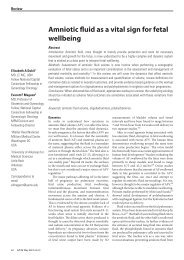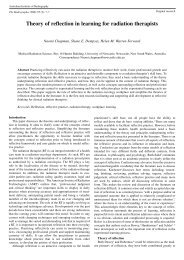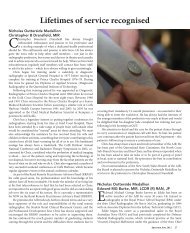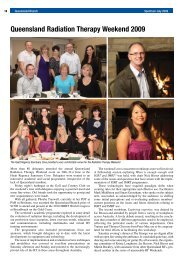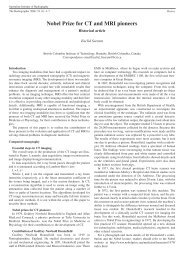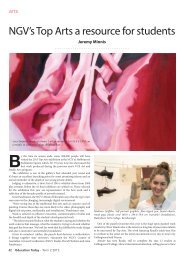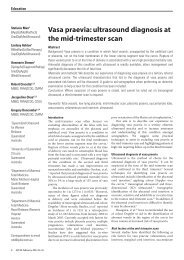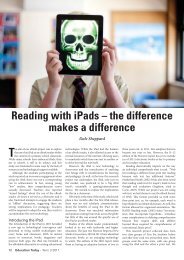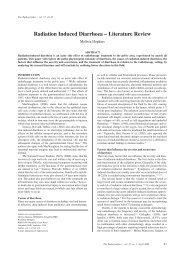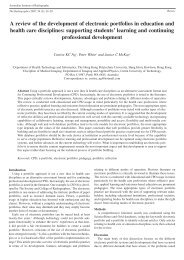A potential role for student portfolios in the medical ... - Minnis Journals
A potential role for student portfolios in the medical ... - Minnis Journals
A potential role for student portfolios in the medical ... - Minnis Journals
You also want an ePaper? Increase the reach of your titles
YUMPU automatically turns print PDFs into web optimized ePapers that Google loves.
Australian Institute of Radiography<br />
Review The Radiographer 2007: 54 (1) 11–13<br />
A <strong>potential</strong> <strong>role</strong> <strong>for</strong> <strong>student</strong> <strong>portfolios</strong><br />
<strong>in</strong> <strong>the</strong> <strong>medical</strong> radiation sciences<br />
Geoffrey M. Currie, Janelle M. Wheat<br />
School of Bio<strong>medical</strong> Sciences, Charles Sturt University, Wagga Wagga, New South Wales 2650, Australia<br />
Correspondence: gcurrie@csu.edu.au<br />
Abstract There is a recognised need <strong>in</strong> higher education to develop au<strong>the</strong>ntic evidence of <strong>student</strong> learn<strong>in</strong>g outcomes. In<br />
<strong>medical</strong> radiation science, <strong>the</strong>re is demand <strong>for</strong> a tool <strong>for</strong> ongo<strong>in</strong>g course quality assurance and au<strong>the</strong>ntic evidence of <strong>the</strong><br />
capabilities, skill base and knowledge base of graduates, with particular reference to <strong>the</strong> requirements <strong>for</strong> professional<br />
accreditation and <strong>the</strong> courses prescribed graduate attributes. The <strong>student</strong> portfolio is considered here as a <strong>potential</strong> tool<br />
<strong>for</strong> this purpose.<br />
As a <strong>for</strong>mative tool, <strong>the</strong> <strong>medical</strong> radiation science <strong>student</strong> portfolio may benefit <strong>in</strong>dustry by deliver<strong>in</strong>g highly selfmotivated,<br />
self-reflective, professional and competent practitioners with reta<strong>in</strong>ed deep understand<strong>in</strong>g of <strong>the</strong>ory conceptualised<br />
to practice. As a summative tool, <strong>the</strong> <strong>student</strong> portfolio would provide au<strong>the</strong>ntic evidence of <strong>student</strong> learn<strong>in</strong>g<br />
outcomes, graduate quality and attributes, and standards of competence.<br />
Keywords: <strong>medical</strong> radiation science, quality assurance, <strong>student</strong> portfolio<br />
Introduction<br />
As a result of rigorous accreditation processes <strong>the</strong> quality of<br />
<strong>medical</strong> radiation science graduates <strong>in</strong> Australia is ma<strong>in</strong>ta<strong>in</strong>ed<br />
at a high <strong>in</strong>ternational standard. The Australian Institute of<br />
Radiography (AIR) and <strong>the</strong> Australia and New Zealand Society<br />
of Nuclear Medic<strong>in</strong>e (ANZSNM) play crucial <strong>role</strong>s as <strong>in</strong>dustry<br />
‘gatekeepers’. University courses graduat<strong>in</strong>g <strong>medical</strong> radiation<br />
science <strong>student</strong>s <strong>for</strong> <strong>the</strong>ir professional development year (PDY)<br />
require cyclic re-accreditation.<br />
Course re-accreditation places <strong>the</strong> onus on <strong>the</strong> <strong>in</strong>stitution to<br />
prove satisfactory standards <strong>for</strong> specific criteria. The major draw<br />
backs of this type of evaluation is <strong>the</strong> currency of <strong>the</strong> competency<br />
based standards employed as <strong>the</strong> benchmark and <strong>the</strong> difficulty <strong>in</strong><br />
provid<strong>in</strong>g tangible evidence of <strong>the</strong>ir satisfaction.<br />
Evidence often relies almost entirely on <strong>the</strong> basis of <strong>student</strong>s<br />
pass<strong>in</strong>g subjects with<strong>in</strong> <strong>the</strong> course. Atta<strong>in</strong><strong>in</strong>g graduate status by<br />
successful completion of all coursework subjects, however, does<br />
not guarantee <strong>the</strong>se proficiencies are carried <strong>in</strong>to professional<br />
practice. In <strong>the</strong> absence of clear strategies foster<strong>in</strong>g deeper learn<strong>in</strong>g<br />
and understand<strong>in</strong>g of key concepts re<strong>in</strong><strong>for</strong>ced by appropriate<br />
assessment strategies, graduation fails to provide concrete evidence<br />
<strong>for</strong> competency based standards. More importantly perhaps,<br />
is <strong>the</strong> idea that <strong>the</strong> PDY plays an important <strong>role</strong> <strong>in</strong> solidify<strong>in</strong>g<br />
<strong>the</strong>se skills <strong>in</strong> <strong>the</strong> novice practitioner prior to full accreditation.<br />
Similarly, a near 100 per cent employment rate may be attributed<br />
to any number of factors o<strong>the</strong>r than satisfaction of required skill<br />
development. For example, a chronic shortage of graduates might<br />
see all graduates ga<strong>in</strong> employment regardless of standards.<br />
The authors of <strong>the</strong> present paper recognised <strong>the</strong> need to develop<br />
au<strong>the</strong>ntic evidence of <strong>student</strong> learn<strong>in</strong>g outcomes. A goal was<br />
set to develop a tool <strong>for</strong> ongo<strong>in</strong>g course quality assurance and<br />
au<strong>the</strong>ntic evidence of <strong>the</strong> capabilities, skill base and knowledge<br />
base of graduates, with particular reference to <strong>the</strong> requirements<br />
<strong>for</strong> professional accreditation and <strong>the</strong> courses prescribed graduate<br />
attributes. The <strong>student</strong> portfolio was considered a suitable tool <strong>for</strong><br />
this purpose. In addition, <strong>the</strong> <strong>student</strong> portfolio may foster deeper<br />
<strong>student</strong> learn<strong>in</strong>g, bridg<strong>in</strong>g undergraduate learn<strong>in</strong>g with postgraduate<br />
competency <strong>the</strong>reby render<strong>in</strong>g <strong>student</strong> graduation a more reliable<br />
<strong>in</strong>dicator of standards of competence.<br />
The concept of a portfolio is not new and, <strong>for</strong> most, <strong>the</strong> artist’s<br />
or model’s portfolio is a familiar image. While <strong>portfolios</strong> are not<br />
a new idea <strong>in</strong> learn<strong>in</strong>g, <strong>the</strong> diversity of fields where <strong>portfolios</strong> provide<br />
an appropriate <strong>for</strong>m of assessment has only recently evolved.<br />
Portfolios are commonplace <strong>in</strong> teacher education yet are without<br />
precedent <strong>in</strong> <strong>the</strong> <strong>medical</strong> radiation sciences. In recent years,<br />
<strong>student</strong> <strong>portfolios</strong> have ga<strong>in</strong>ed strong support from educators<br />
because <strong>the</strong>y provide au<strong>the</strong>ntic evidence of learn<strong>in</strong>g and because<br />
<strong>the</strong>y provide an attractive alternative to traditional assessment.<br />
Portfolio development is an act of creative self-expression<br />
whose journey (<strong>the</strong> process) offers an opportunity <strong>for</strong> reflection<br />
and self development. A portfolio, while not an exhaustive collection<br />
of ones work, needs to provide an accurate representation of<br />
ones breadth, depth and quality of work. In learn<strong>in</strong>g, unlike <strong>the</strong><br />
photographs <strong>in</strong> a model’s portfolio, evidence is most often provided<br />
by <strong>in</strong>direct means. It is not always possible or practical to<br />
evaluate <strong>student</strong> learn<strong>in</strong>g directly and, more importantly, it offers<br />
little validity to evaluate <strong>student</strong> learn<strong>in</strong>g from ei<strong>the</strong>r a s<strong>in</strong>gle<br />
perspective (e.g. module exam<strong>in</strong>ation) or a s<strong>in</strong>gle experience (e.g.<br />
one lecture). 1<br />
The <strong>student</strong> portfolio is a tool employed to collect and reflect<br />
on experiences and achievements and acts as a catalyst to connect<br />
knowledge with experiences; academic, cl<strong>in</strong>ical, emotional and<br />
social. For some, <strong>the</strong> portfolio may provide a ‘product’ to be used<br />
<strong>for</strong> summative evaluation and decision mak<strong>in</strong>g while <strong>for</strong> o<strong>the</strong>rs,<br />
<strong>the</strong> portfolio is a ‘process’ to be used <strong>for</strong> <strong>for</strong>mative evaluation,<br />
reflection and self development. 2,3
12<br />
The Radiographer<br />
Geoffrey M. Currie, Janelle M. Wheat<br />
Def<strong>in</strong><strong>in</strong>g <strong>the</strong> portfolio will depend on ones perspective.<br />
Portfolios have been def<strong>in</strong>ed as a purposeful collection of <strong>student</strong><br />
work assembled to demonstrate progress and achievement, 4<br />
an opportunity <strong>for</strong> multidimensional assessment 5 and a tool to<br />
enhance course <strong>in</strong>struction. 6 The purpose might be expanded to<br />
<strong>in</strong>clude ‘engag<strong>in</strong>g <strong>student</strong>s <strong>in</strong> <strong>the</strong>ir learn<strong>in</strong>g and help<strong>in</strong>g <strong>student</strong>s<br />
develop self evaluation/reflection skills’. 7 Portfolio development<br />
promotes knowledge construction because <strong>the</strong> <strong>student</strong> is challenged<br />
to reflect and <strong>in</strong>terpret teach<strong>in</strong>g and learn<strong>in</strong>g practices. 8,9<br />
Student <strong>portfolios</strong> do, however, fall short of realis<strong>in</strong>g this<br />
<strong>potential</strong> when <strong>the</strong> portfolio implementation program is <strong>in</strong>adequate.<br />
One problem with portfolio development is that <strong>student</strong>s<br />
may allow <strong>the</strong> evidence at hand to control <strong>the</strong> direction of <strong>the</strong><br />
portfolio. The reflection <strong>the</strong>n, is based on <strong>the</strong> available evidence<br />
ra<strong>the</strong>r than offer<strong>in</strong>g a true reflection of ones underly<strong>in</strong>g philosophy.<br />
10 The outcome is a portfolio that focuses on ‘what’ ra<strong>the</strong>r<br />
than ‘why’ 10 but more importantly, may fall short of contribut<strong>in</strong>g<br />
to improved <strong>student</strong> learn<strong>in</strong>g, improved <strong>student</strong> professionalism<br />
or improved course management.<br />
Shulman 11 suggests that motivations <strong>for</strong> portfolio development<br />
can be diverted with <strong>the</strong> resultant work represent<strong>in</strong>g an exhibition<br />
denuded of substance. Dollase 12 reported that portfolio development<br />
does not necessarily result <strong>in</strong> <strong>in</strong>creased reflection or quality<br />
improvement. The problem, <strong>in</strong> part, relates to <strong>the</strong> def<strong>in</strong>ition of a<br />
portfolio. A portfolio needs to be more than a vestibule of evidence,<br />
<strong>the</strong> portfolio also echoes <strong>the</strong> attitude of a dynamic process<br />
of a broad spectrum of valid evidence over time. 13 Students may<br />
focus too closely on <strong>the</strong> f<strong>in</strong>al product ra<strong>the</strong>r than <strong>the</strong> process and,<br />
as a result, <strong>the</strong> <strong>student</strong> ‘becomes an expert at portfolio development’<br />
ra<strong>the</strong>r than improv<strong>in</strong>g <strong>the</strong>ir learn<strong>in</strong>g experiences: but only<br />
<strong>in</strong> <strong>the</strong> absence of effective implementation of a portfolio program.<br />
A <strong>student</strong> portfolio needs to be both strongly self-motivated and<br />
<strong>in</strong>novatively promoted and supported by faculty.<br />
There is a broad spectrum of literature aimed at quality<br />
improvement, purport<strong>in</strong>g <strong>the</strong> use of <strong>portfolios</strong> as a tool <strong>for</strong> quality<br />
improvement, and focuss<strong>in</strong>g <strong>the</strong> portfolio toward a <strong>student</strong>’s<br />
strengths and achievements. While <strong>the</strong>re is a demonstrated need<br />
<strong>for</strong> a representative account of ones achievements, <strong>the</strong>re lies a<br />
trap <strong>in</strong> <strong>the</strong> bias associated with only <strong>in</strong>clud<strong>in</strong>g ones strengths and<br />
accomplishments. Campbell et al. 14 <strong>in</strong>dicate that <strong>the</strong> portfolio<br />
must present an honest account of ones capabilities <strong>for</strong> it to offer<br />
a powerful tool. True reflection, one might assume, requires a<br />
balanced account of strengths and weaknesses. Moreover, one<br />
may have more to ga<strong>in</strong> <strong>in</strong> terms of quality improvement from<br />
honest reflection and evaluation of ones weaknesses and failures.<br />
Regardless of <strong>the</strong> purpose of <strong>the</strong> portfolio, it should conta<strong>in</strong> a<br />
detailed analysis of strengths, weaknesses, opportunity and threats<br />
(SWOT analysis). Both summative and <strong>for</strong>mative <strong>role</strong>s of <strong>the</strong> <strong>student</strong><br />
portfolio demand a balanced account of ones learn<strong>in</strong>g.<br />
The <strong>role</strong> of <strong>the</strong> portfolio <strong>in</strong> <strong>medical</strong> radiation science<br />
The portfolio provides a tool to build on exist<strong>in</strong>g holistic, deep<br />
and lifelong learn<strong>in</strong>g <strong>in</strong>itiatives employed <strong>in</strong> <strong>the</strong> undergraduate<br />
education of <strong>medical</strong> radiation science <strong>student</strong>s. Structured<br />
and guided portfolio development and reflection may enhance<br />
<strong>student</strong> learn<strong>in</strong>g, motivation, retention rates and graduation<br />
rates by illum<strong>in</strong>at<strong>in</strong>g connections between <strong>the</strong> <strong>student</strong>s’ learn<strong>in</strong>g<br />
experiences. Moreover, <strong>the</strong> portfolio may highlight connections<br />
between <strong>the</strong> <strong>student</strong>s’ learn<strong>in</strong>g experiences and <strong>the</strong>ir academic<br />
and career goals. Thus, <strong>the</strong> portfolio offers a tool <strong>for</strong> enhanc<strong>in</strong>g<br />
deeper learn<strong>in</strong>g and foster<strong>in</strong>g life long learn<strong>in</strong>g, improv<strong>in</strong>g <strong>the</strong><br />
quality of graduates enter<strong>in</strong>g <strong>in</strong>dustry and foster<strong>in</strong>g a professional<br />
culture of cont<strong>in</strong>u<strong>in</strong>g professional development. In addition, it<br />
provides au<strong>the</strong>ntic evidence of <strong>student</strong> learn<strong>in</strong>g and achievement<br />
to enhance postgraduate employment prospect. More significantly,<br />
this au<strong>the</strong>ntic evidence provides a valuable resource <strong>for</strong> <strong>in</strong>ternal<br />
course management (e.g. curriculum and pedagogy judgments)<br />
and external course review (e.g. course accreditation). Clearly,<br />
employ<strong>in</strong>g this tool <strong>for</strong> course quality improvement serves to<br />
fur<strong>the</strong>r improve <strong>student</strong> learn<strong>in</strong>g and success.<br />
Implementation<br />
Students should be advised, guided and <strong>in</strong>structed through <strong>the</strong><br />
portfolio development process. The portfolio should be a collective<br />
works spann<strong>in</strong>g <strong>the</strong> duration of a <strong>student</strong>’s studies. Students<br />
should be <strong>in</strong>structed that <strong>the</strong>ir portfolio:<br />
n consists of relevant material that has been ga<strong>the</strong>red dur<strong>in</strong>g <strong>the</strong><br />
course of <strong>the</strong>ir studies that provides evidence of <strong>the</strong>ir progression<br />
towards excellence;<br />
n will build on <strong>the</strong>ir current work and may permit <strong>the</strong>m to develop<br />
an extract that can be used <strong>for</strong> resume development and job<br />
<strong>in</strong>terviews;<br />
n provides evidence that both subject objectives and graduate<br />
attributes have been atta<strong>in</strong>ed, and<br />
n should syn<strong>the</strong>sise <strong>the</strong> material ga<strong>the</strong>red <strong>for</strong> <strong>the</strong> portfolio and<br />
reflect on its implication <strong>for</strong> career development.<br />
There are three pillars <strong>for</strong> develop<strong>in</strong>g a career <strong>in</strong> <strong>the</strong> <strong>medical</strong><br />
radiation sciences; academic, cl<strong>in</strong>ical and emotional skills. As<br />
such, <strong>the</strong> portfolio should be broadly divided <strong>in</strong>to <strong>the</strong> follow<strong>in</strong>g<br />
head<strong>in</strong>gs:<br />
n Personal details<br />
n Academic / <strong>the</strong>ory / knowledge<br />
n Cl<strong>in</strong>ical competence / skills / expertise<br />
n Emotional skills / competence<br />
For each of <strong>the</strong> three pillar head<strong>in</strong>gs, <strong>student</strong>s should develop a<br />
philosophy or an ‘I believe…’ statement and should also <strong>in</strong>dicate<br />
achievements <strong>in</strong> each of <strong>the</strong> pillars. For each of <strong>the</strong> pillars, an ‘I<br />
will…’ statement should also be developed to <strong>in</strong>dicate <strong>the</strong>ir goals<br />
and objectives. Their statements of philosophy, achievement and<br />
goals should be supported by some reflective commentary.<br />
For each subject a <strong>student</strong> undertakes <strong>in</strong> a given semester,<br />
he / she should reflect on <strong>the</strong> learn<strong>in</strong>g objectives and generic skills<br />
of <strong>the</strong> subject. Were <strong>the</strong>y achieved? How were <strong>the</strong>y achieved?<br />
They should also reflect on <strong>the</strong> contribution of each subject to <strong>the</strong><br />
graduate attributes of <strong>the</strong> course as def<strong>in</strong>ed by both <strong>the</strong> University<br />
and <strong>the</strong> accredit<strong>in</strong>g body, however, <strong>the</strong>y need to be aware that not<br />
all subjects address all graduate attributes.<br />
Students should reflect on what <strong>the</strong>ir degree has given <strong>the</strong>m:<br />
n Cl<strong>in</strong>ical skills, knowledge, emotional skills etc.<br />
n How do <strong>the</strong>y feel <strong>the</strong> degree has placed <strong>the</strong>m <strong>for</strong> <strong>the</strong>ir future<br />
career?<br />
n Do <strong>the</strong>y feel <strong>the</strong>y have ga<strong>in</strong>ed a competitive advantage?<br />
n Do <strong>the</strong>y feel <strong>the</strong>re has been an omission from <strong>the</strong>ir education<br />
and tra<strong>in</strong><strong>in</strong>g?<br />
n Does this omission present as a disadvantage to <strong>the</strong>m?<br />
n Has <strong>the</strong>ir time at university provided <strong>the</strong>m with ‘deeper understand<strong>in</strong>g’<br />
of key concepts? How or why not?<br />
n Do <strong>the</strong>y th<strong>in</strong>k a philosophy of ‘life long learn<strong>in</strong>g’ has been<br />
fostered? How or why not?<br />
n Did <strong>the</strong>ir degree foster or facilitate a philosophy of ‘pride <strong>in</strong><br />
workmanship’? How or why not?<br />
Students should document and catalogue <strong>the</strong>ir learn<strong>in</strong>g experiences<br />
throughout <strong>the</strong> semester, relat<strong>in</strong>g this material to <strong>the</strong> subject<br />
objectives and <strong>in</strong>clud<strong>in</strong>g <strong>the</strong> distilled syn<strong>the</strong>sis of this <strong>in</strong> <strong>the</strong>ir
A <strong>potential</strong> <strong>role</strong> <strong>for</strong> <strong>student</strong> <strong>portfolios</strong> <strong>in</strong> <strong>the</strong> <strong>medical</strong> radiation sciences<br />
The Radiographer 13<br />
portfolio. It is important that learn<strong>in</strong>g experiences are <strong>in</strong>cluded<br />
from across <strong>the</strong> semester, so <strong>the</strong>y should view this as an on-go<strong>in</strong>g<br />
piece of assessment. They should <strong>in</strong>clude artefacts <strong>in</strong> <strong>the</strong> portfolio<br />
where available and appropriate (e.g. patient feedback, supervisor<br />
feedback, grades, participation <strong>in</strong> workshops/conferences etc.).<br />
Expected outcomes<br />
There are a number of opportunities or benefits offered by<br />
implementation of an effective <strong>student</strong> portfolio development<br />
program, <strong>in</strong>clud<strong>in</strong>g: 3,15,16<br />
n Allow <strong>student</strong>s to set and meet goals, to show growth, to assess<br />
<strong>the</strong>ir own work (collect, select and reflect – and project); cont<strong>in</strong>uous<br />
improvement.<br />
n Encourages accountability by giv<strong>in</strong>g <strong>student</strong>s responsibility<br />
<strong>for</strong> quality management <strong>in</strong> <strong>the</strong>ir learn<strong>in</strong>g; <strong>student</strong>s become<br />
engaged <strong>in</strong> and take ownership of <strong>the</strong>ir learn<strong>in</strong>g.<br />
n Provides a tool <strong>for</strong> more robust evaluation of learn<strong>in</strong>g effectiveness<br />
and improvement allow<strong>in</strong>g <strong>in</strong>dividual <strong>student</strong>s to<br />
def<strong>in</strong>e <strong>the</strong>mselves; monitor<strong>in</strong>g academic growth.<br />
n Encourages a culture where learn<strong>in</strong>g is both valued and cont<strong>in</strong>ually<br />
improved; consistent with lifelong learn<strong>in</strong>g philosophy.<br />
n Complements developmentally appropriate curriculum and<br />
pedagogy. Portfolios can improve <strong>in</strong>struction, assessment,<br />
communication and professional development.<br />
n Demonstrates significantly more about a <strong>student</strong>’s knowledge,<br />
understand<strong>in</strong>g, growth and professionalism than a grade.<br />
Grades generally represent a ‘snapshot’ of <strong>student</strong> learn<strong>in</strong>g.<br />
n Allows assessment of <strong>in</strong>dividual learn<strong>in</strong>g styles, enhances <strong>the</strong><br />
ability to communicate about learn<strong>in</strong>g and ensures accountability.<br />
They enhance <strong>the</strong> academics awareness of <strong>the</strong> <strong>in</strong>dividual<br />
learn<strong>in</strong>g needs and academic progress of <strong>student</strong>s.<br />
n Alignment of learn<strong>in</strong>g objectives with assessment.<br />
n Consistent with <strong>student</strong> centred learn<strong>in</strong>g environments; associated<br />
with improved motivation and engagement <strong>in</strong> <strong>the</strong>ir work.<br />
n Changes <strong>the</strong> learn<strong>in</strong>g culture by promot<strong>in</strong>g <strong>in</strong>tr<strong>in</strong>sic motivation<br />
ra<strong>the</strong>r than rely<strong>in</strong>g on extr<strong>in</strong>sic motivators <strong>for</strong> per<strong>for</strong>mance.<br />
n They serve as a tool to evaluate <strong>the</strong> effectiveness of teach<strong>in</strong>g<br />
and teach<strong>in</strong>g materials provid<strong>in</strong>g a quality assurance mechanism<br />
<strong>for</strong> course content and delivery.<br />
n Disclose au<strong>the</strong>ntic evidence of learn<strong>in</strong>g outcomes <strong>for</strong> course<br />
management and decision-mak<strong>in</strong>g.<br />
The benefits outl<strong>in</strong>ed above share a common <strong>the</strong>me; quality<br />
improvement.<br />
The expected outcomes of <strong>student</strong> portfolio implementation <strong>in</strong><br />
<strong>the</strong> <strong>medical</strong> radiation sciences <strong>in</strong>cludes:<br />
n Provide au<strong>the</strong>ntic evidence to support course re-accreditation<br />
and ongo<strong>in</strong>g course management.<br />
n Foster deeper learn<strong>in</strong>g and understand<strong>in</strong>g.<br />
n Promote <strong>student</strong> driven <strong>in</strong>tegrative learn<strong>in</strong>g.<br />
Conclusion<br />
As a <strong>for</strong>mative tool, <strong>the</strong> <strong>medical</strong> radiation science <strong>student</strong><br />
portfolio benefits <strong>in</strong>dustry by deliver<strong>in</strong>g highly self-motivated,<br />
self-reflective, professional and competent practitioners with<br />
reta<strong>in</strong>ed deep understand<strong>in</strong>g of <strong>the</strong>ory conceptualised to practice.<br />
This would contribute positively to <strong>the</strong> collective knowledge and<br />
skills base of <strong>the</strong> profession, <strong>the</strong> standard and quality of practice,<br />
<strong>the</strong> professionalism of <strong>in</strong>dustry and <strong>the</strong> status on <strong>the</strong> <strong>in</strong>ternational<br />
stage. The magnitude of <strong>the</strong> positive impact will <strong>in</strong>crease if implemented<br />
across multiple universities.<br />
As a summative tool, <strong>the</strong> <strong>student</strong> portfolio provides au<strong>the</strong>ntic<br />
evidence of graduate quality and attributes. Not only does this<br />
evidence provide more effective program quality management<br />
(improv<strong>in</strong>g graduate quality and competence) but it also provides<br />
<strong>potential</strong> employers of graduates with a tool to make better judgments<br />
on recruitment, align<strong>in</strong>g <strong>student</strong> goals and capabilities with<br />
departmental needs and opportunity. More importantly, however,<br />
<strong>the</strong> portfolio provides au<strong>the</strong>ntic evidence of <strong>student</strong> learn<strong>in</strong>g outcomes<br />
and standards of competence <strong>for</strong> <strong>the</strong> purposes of course<br />
re-accreditation (or <strong>in</strong>ternal course review).<br />
References<br />
1 Centre <strong>for</strong> Excellence <strong>in</strong> Learn<strong>in</strong>g and Teach<strong>in</strong>g (CELT), Teach<strong>in</strong>g <strong>portfolios</strong>.<br />
The Penn State ID Newsletter 1993 November.<br />
2 Centre <strong>for</strong> Instructional Development and Research (CIDR), Develop<strong>in</strong>g a<br />
teach<strong>in</strong>g portfolio. Teach<strong>in</strong>g and Learn<strong>in</strong>g Bullet<strong>in</strong> 1998; 1 (1).<br />
3 Mues F, Sorc<strong>in</strong>elli, M. Prepar<strong>in</strong>g a teach<strong>in</strong>g portfolio. Amherst Mass.:<br />
University of Massachusetts, The Centre <strong>for</strong> Teach<strong>in</strong>g; 2000.<br />
4 Herman L, Morrell M. Educational progressions: Electronic <strong>portfolios</strong> <strong>in</strong> a<br />
virtual classroom. T.H.E. Journal 1999; 26: 86–9.<br />
5 Cole D, Toml<strong>in</strong> J, Ryan C, Sutton S. L<strong>in</strong>k<strong>in</strong>g technology and best practices:<br />
PRAXIS based electronic <strong>portfolios</strong>. Paper presented at <strong>the</strong> Annual Meet<strong>in</strong>g<br />
of <strong>the</strong> American Association of Colleges <strong>for</strong> Teacher Education. Wash<strong>in</strong>gton<br />
D.C.; 1999.<br />
6 Corbett-Perez S, Dorman S. Electronic <strong>portfolios</strong> enhance health <strong>in</strong>struction.<br />
The Journal of School Health 1999; 69: 247–49.<br />
7 Kimeldorf. A teachers guide to creat<strong>in</strong>g <strong>portfolios</strong>. M<strong>in</strong>neapolis Mo.: Free<br />
Spirit Publish<strong>in</strong>g; 1994.<br />
8 Avraamidou L, Zembal-Saul C. Mak<strong>in</strong>g <strong>the</strong> case <strong>for</strong> <strong>the</strong> use of web-based <strong>portfolios</strong><br />
<strong>in</strong> support of learn<strong>in</strong>g to teach. Journal of Interactive Onl<strong>in</strong>e Learn<strong>in</strong>g<br />
2002; 1 (1): 1–19.<br />
9 Hunter L. Text nouveau: visible structure <strong>in</strong> text presentation. Computer<br />
Assisted Language Learn<strong>in</strong>g 1998; 11: 363–79.<br />
10 Seld<strong>in</strong> P. The teach<strong>in</strong>g portfolio: A practical guide to improved per<strong>for</strong>mance<br />
and promotion / tenure decisions, 2nd edition. Bolton, Mass., USA: Anker<br />
Publish<strong>in</strong>g Company; 1997.<br />
11 Shulman L (ed.). Teacher <strong>portfolios</strong>: a <strong>the</strong>oretical activity. New York, N.Y.:<br />
Teacher College Press; 1998.<br />
12 Dollase R. The Vermont experience <strong>in</strong> state-mandated portfolio approval.<br />
Journal of Teacher Education 1996; 47 (2): 85–98.<br />
13 Wolf K. The schoolteacher’s portfolio: issues <strong>in</strong> design, implementation and<br />
evaluation. Phi Delta Kappan 1991; 73 (2): 129–36.<br />
14 Campbell D, Cignetti P, Melenyzer B, Nettles D, Wyman R. How to develop a<br />
professional portfolio. Boston, Mass.: Pearson Education Inc.; 2004.<br />
15 Danielson C. An <strong>in</strong>troduction to us<strong>in</strong>g <strong>portfolios</strong> <strong>in</strong> <strong>the</strong> classroom. Alexandria,<br />
V.A.: Association <strong>for</strong> supervision and curriculum development; 1997.<br />
16 Hutch<strong>in</strong>gs P. Mak<strong>in</strong>g teach<strong>in</strong>g community property: A menu <strong>for</strong> peer collaboration<br />
and peer review. Wash<strong>in</strong>gton D.C.: American Association <strong>for</strong> Higher<br />
Education; 1993.



